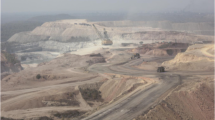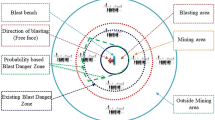Abstract
The present study has been conducted in surface limestone mine to select the controllable blasting design parameters affecting the peak particle velocity (PPV) for assessment of ground vibration. The study aims at using two prominent statistical tools, namely, principal component analysis (PCA) and stepwise selection and elimination (SSE) techniques for identifying the key controllable parameters affecting the PPV. For determining the correlation coefficient between blasting design parameters and PPV from 44 field scale trial blasts, multi-variate linear regression (MLR) technique was done. It was found that the PCA and SSE eliminated a huge number of controllable parameters to identify the most important parameters, affecting the PPV. The PCA eliminated 6 number of parameters while SSE eliminated 5 number of parameters, and the coefficients of determination (R2) obtained were 0.616 and 0.584 for PCA and SSE respectively. The predictor equations were evolved, and these equations were used to validate the PPV results for another set of 21 field scale trial blasts. The predictor equations have been found to be fairly accurate in predicting the PPV values. Further, the PCA technique provides very near prediction of PPV with high degree of correlation in comparison to SSE technique. The paper highlights the role of state-of-art statistical tools in selecting the blasting design parameters affecting the PPV in field-scale blasting.




Similar content being viewed by others
References
Chen G, Huang SL (2001) Analysis of ground vibrations caused by open pit production blasts. J Fragblast 5:91–107
Chen W, Hasanipanah M, Rad HN, Armaghani DJ, Tahir MM (2019) A new design of evolutionary hybrid optimization of SVR model in predicting the blast-induced ground vibration. J Eng Comput 12:1–7
Amiri M, Hasanipanah M, Amnieh HB (2020) Predicting ground vibration induced by rock blasting using a novel hybrid of neural network and itemset mining. J Neural Comput Appl 9:1–9
Hagan TN (1980) Rock breakage by explosives. In: Gasdynamics of explosions and reactive systems. Elsevier, pp 329–340
Rosenthal MF, Morlock GL(1987) Blasting guidance manual. In: Office of Surface Mining Reclamation and Enforcement, United States Department of the Interior, USA
Khandelwal M, Singh TN (2006) Prediction of blast induced ground vibrations and frequency in opencast mine: a neural network approach. J Sound Vib 289(4-5):711–725
Ding X, Hasanipanah M, Rad HN, Zhou W (2020) Predicting the blast-induced vibration velocity using a bagged support vector regression optimized with firefly algorithm. J Eng Comput 23:1–12
Yang H, Rad HN, Hasanipanah M, Amnieh HB, Nekouie A (2020) Prediction of vibration velocity generated in mine blasting using support vector regression improved by optimization algorithms. J Nat Resour Res 29(2):807–830
Bhandari S (1997) Engineering rock blasting operations. A.A. Balkema, Rotterdam, Netherlands
Saadat M, Khandelwal M, Monjezi M (2014) An ANN-based approach to predict blast-induced ground vibration of Gol-E-Gohar iron ore mine, Iran. J Rock Mech Geotech Eng 6(1):67–76
Hasanipanah M, Golzar SB, Larki IA, Maryaki MY, Ghahremanians T (2017) Estimation of blast-induced ground vibration through a soft computing framework. J Eng Comput 33(4):951–959
Hasanipanah M, Amnieh HB, Khamesi H, Armaghani DJ, Golzar SB, Shahnazar A (2018) Prediction of an environmental issue of mine blasting: an imperialistic competitive algorithm-based fuzzy system. Int J Environ Sci Technol 15(3):551–560
Roach PK, Verster WF (2006) Discussing the detonation effects of large charges. In: SABO Conference. pp 15–17
Davies B, Farmer IW, Attewell PB (1964) Ground vibration from shallow sub-surface blasts. J Eng 217(5644):553–559
Ambraseys NN, Hendron AJ (1968) Dynamic behavior of rock masses, rock mechanics, In: Stagg and Zeinkiewicz (eds.). Engineering Practice, John Wiley and Sons Inc., London, pp 203–227
Dowding CH (1992) Suggested method for blast vibration monitoring. Int J Rock Mech Min Geomech Abstr 29(2):143–156
Duvall WI, Fogelson DE (1962) Review of criteria for estimating damage to residences from blasting vibrations. US Department of the Interior, Bureau of Mines, R.I. 5968
Nicholls HR, Johnson CF, Duvall WI (1971) Blasting vibrations and their effects on structures. US Dept. of the Interior, Bureau of Mines, Washington, DC, pp 656–660
Jolliffe IT (2002) Principal components in regression analysis. In: Principal Component Analysis. Springer, New York, pp 167–198
Tiryaki B (2008) Predicting intact rock strength for mechanical excavation using multivariate statistics, artificial neural networks, and regression trees. J Eng Geol 99(1-2):51–60
Majdi A, Beiki M (2010) Evolving neural network using a genetic algorithm for predicting the deformation modulus of rock masses. Int J Rock Mech Min Sci 47(2):246–253
Aler J, Du Mouza J, Arnould M (1996) Evaluation of blast fragmentation efficiency and its prediction by multivariate analysis procedures. Int J Rock Mech Min Sci Geomech Abstr 7(33):315A
Martínez-Martínez J, Benavente D, Ordóñez S, Garcia-del-Cura M (2008) Multivariate statistical techniques for evaluating the effects of brecciated rock fabric on ultrasonic wave propagation. Int J Rock Mech Min Sci 45(4):609–620
Wang M, Wright J, Brownlee A, Buswell R (2016) A comparison of approaches to stepwise regression on variables sensitivities in building simulation and analysis. J Energy Buildings 127:313–326
Khandelwal M, Singh TN (2007) Evaluation of blast-induced ground vibration predictors. J Soil Dyn Earthquake Eng 27(2):116–125
Verma AK, Singh TN (2013) Comparative study of cognitive systems for ground vibration measurements. J Neural Comput Appl 22(1):341–350
Krabbe P (2016) The measurement of health and health status: concepts, methods and applications from a multidisciplinary perspective. London, UK, Academic Press, pp 113–115
Pearson KL III (1901) On lines and planes of closest fit to systems of points in space. J London, Edinburgh, Dublin Philos Mag J Sci 2(11):559–572
Hotelling H (1933) Analysis of a complex of statistical variables into principal components. J Educ Psychol 24(6):417
Jackson DA (1993) Stopping rules in principal components analysis: a comparison of heuristical and statistical approaches. J Ecol 74(8):2204–2214
Smith G (2018) Step away from stepwise. J Big Data 5(1):32
Efroymson MA (1960) Multiple regression analysis. In: Ralston A, Wilf HS (eds) Mathematical methods for digital computers. Wiley, New York
Kecman V (2007) Foreword. In: Cios KJ, Pedrycz W, Swiniarski RW, Kurgan LA (eds) Data mining: a knowledge discovery approach. Springer, New York
Pan Y, Yang C, An R, Sun Y (2016) Fault detection with improved principal component pursuit method. J Chemom Intell Lab Syst 157:111–119
Montgomery DC, Peck EA, Vining GG (2012) Introduction to linear regression analysis. John Wiley & Sons, New York, USA
Polhemus NW (2005) How to: Deal with multi-collinearity when fitting a regression model using STATGRAPHICS Centurion. Statpoint Technologies, Inc. pp 1–18
Jolliffe IT, Cadima J (2016) Principal component analysis: a review and recent developments. J Philos Trans R Soc A: Math Phys Eng Sci 374(2065):20150202
Gajjar S, Kulahci M, Palazoglu A (2018) Real-time fault detection and diagnosis using sparse principal component analysis. J Process Control 67:112–128
Sarkhosh M, Ghasemi JB, Ayati M (2012) A quantitative structure-property relationship of gas chromatographic/mass spectrometric retention data of 85 volatile organic compounds as air pollutant materials by multivariate methods. J Chem Cent J 6(2):S4
Acknowledgements
The authors express their deep sense of gratitude towards the staff and management of the open cast limestone mines for their excellent cooperation and support throughout the field work.
Author information
Authors and Affiliations
Contributions
All authors contributed to the design and implementation of the research, to the analysis of the results, and to the writing of the manuscript and also read and approved the final manuscript.
Corresponding author
Ethics declarations
Conflict of Interest
The authors declare no competing interests.
Additional information
Publisher’s Note
Springer Nature remains neutral with regard to jurisdictional claims in published maps and institutional affiliations.
Rights and permissions
About this article
Cite this article
Paurush, P., Rai, P. & Sharma, S.K. Selection of Blasting Design Parameters Affecting Peak Particle Velocity—a Case Study. Mining, Metallurgy & Exploration 38, 1435–1447 (2021). https://doi.org/10.1007/s42461-021-00408-9
Received:
Accepted:
Published:
Issue Date:
DOI: https://doi.org/10.1007/s42461-021-00408-9




